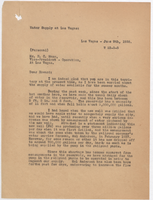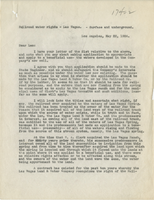Search the Special Collections and Archives Portal
Search Results

Letter from Walter R. Bracken (Las Vegas) to J. P. Mack (Los Angeles), March 25, 1938
Date
Archival Collection
Description
References a Las Vegas Springs inspection. Damage to the housing around the Big Spring was found and repairs were requested.
Text

Memo from Walter R. Bracken to W. H. Hulsizer about water usage, March 28, 1938
Date
Archival Collection
Description
Water used by the Las Vegas Land and Water Company and the Los Angeles & Salt Lake Railroad Company in 1932
Text

Letter from Walter R. Bracken (Las Vegas) to H. C. Mann (Las Vegas) regarding Las Vegas water supply, June 9, 1938
Date
Archival Collection
Description
Las Vegas was just entering the hottest part of the year and well No. 1 had dropped off production considerably.
Text

Chart, Comparative statement of water produced at Las Vegas for June and July in years between 1931 and 1938, June 9, 1938
Date
Archival Collection
Description
Water production from five months between 1931 and 1938
Text

Memo about weir water measurements from Las Vegas springs and wells, May 18, 1938
Date
Archival Collection
Description
A delegation from the Las Vegas Land and Water Company and local and state agencies was present to take weir water measurements from Las Vegas springs and wells.
Text

Letter from Walter R. Bracken (Las Vegas) to Roscoe Moss (Los Angeles), June 10, 1938
Date
Archival Collection
Description
Well No. 2 had dropped production from 2.5 million gallons a day to 700,000 gallons, and Bracken discussed possible remedies.
Text

Letter from General Counsel (Las Vegas) to H. I. Bettis regarding Las Vegas water system maintenance, Dec. 11, 1906
Date
Archival Collection
Description
General Counsel recommends an examination of the water rights and water properties embraced in the mortgage, and an examination of the title deeds before the railroad company makes any real estate decisions.
Text

Letter from H. I. Bettis (Los Angeles) to A. S. Halsted, January 9, 1910
Date
Archival Collection
Description
The county received a preferred water rate. At Block 20, they had 12 taps, and rather than install 12 meters, they paid a flat rate. They now wanted to pay for one tap. Bettis was asking if the Las Vegas Land and Water Company could cut out the other taps and meter the remaining one.
Text

Letter from the Las Vegas Chamber of Commerce to W. H. Comstock, A. S. Halstead, W. R. Bracken, and J. Ross Clark, August 13, 1919
Date
Archival Collection
Description
Letter stating that low water pressure had been a serious problem during the last three fires in Las Vegas and should be fixed. If irrigation was the culprit, then the city commission should enact watering restrictions.
Text

Letter from F. R. McNamee (Los Angeles) to Leo [McNamee], May 22, 1924
Date
Archival Collection
Description
McNamee states that although the Union Pacific Railroad owns the land that the springs are on and all the land it historically watered, to further protect their water right they should apply for the right to appropriate the water.
Text
